|
By August 1st, 1944 the Soviet armies had reached the Vistula
on a broad front and the reconnaissance detachments were already in the Warsaw suburb of Praga west of the river. Thus encouraged,
General Bor-Komorowski, the Polish insurgent leader, called his 35,000 partisans on to the Warsaw streets to fight the Germans.
The Revolt in Warsaw was a major threat since it cut communications to 9th Army, still fighting farther east. The city had
not been declared part of the Army operations zone and so Generaloberst Guderian,
the Army Chief-of-Staff, applied to Hitler to have Warsaw placed under the Wehrmacht so that Heer might put
down the revolt. Hitler refused; the task was allotted to Himmler as Commander-in-Chief of the Ersatzheer.
Himmler was chosen for this task because by making suppression an
SS affair it was intended to leave regular Army free to face the Red Army. It is also clear that SS want to have a completely
free hand - free from observation, much less interference, by possibly "squeamish" elements. And for those who may have wondered
that, at this late stage in war and after so much horrific brutality, could possibly make anyone
squeamish, the answer was not long in coming.
Himmler ordered to the Warsaw front the head of his anti-partisan
formations, SS-Obergruppenführer Erich
von dem Bach-Zelewski. A veteran of many a killing ground, von dem Bach picked as his lieutenants two of the more exotic characters
in the sinister gallery of Waffen SS degenerates. The outfits of which the couples in charge were equally bizarre - the Kaminski
and Dirlewanger brigades.
The Russians Turncoat Formation
The full title of Waffen-Brigadeführer der SS Bronislav Vladislavovich Kaminski's
group was the Russian SS Assault Brigade RONA (Russkaya Oswoboditeljnaja Narodnaja
Armya - the Russian National Liberation Army). RONA sprung into existence because one German general had refused to implement
Nazi's anti-Slav policy in occupied Russian and had set up a large autonomous Russian district. The first Russian volunteer
sections had sprung up there, consisting largely of fanatically anti-Soviet peasants.
The unpromising rabble had been knocked in to shape as a sort of
auxiliary army for Germany. When its Russian commander fell during a skirmish with partisans, Kaminski, a White Russian engineer
who had Polish-German blood mixed in his vein, took over and was appointed by Himmler to head the 29. Waffen Grenadierdivision der SS RONA (Russian).
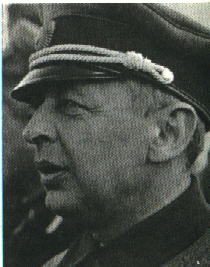
|
| SS-Brigadefuehrer Kaminski. |
Here indeed was a strange mongrel! Kaminski's army was inexperienced,
adventurous, impulsive and, in textbook military terms, a total disaster. After the reversals on the Eastern Front, which
forced them to withdraw into hostile territory, mutinies and desertions became common. It was reputed that Kaminski flew to
each respective regimental headquarters and shot the deserters and mutineers personally as a way of installing some sort of
discipline in the division.
But there was a positive benevolence about it when compared with
Oskar Dirlewanger's Police Brigade.
The Thugs Brigade
The Dirlewanger Brigade were one of the most terrible units Europe
had ever known. Not since the hordes of Genghis Khan had there been such a rabble of butchers and sadist organized under one
nation's flag.
As a Doctor of Political Science at Frankfurt University, Oscar Dirlewanger
might well have had a promising career if he had not been removed and imprisoned for indecently assaulting female minor and
other sex crimes of a vile nature. Luckily for him, however, he had good friends in the SS: Gottlob Berger, the head of recruitment
for the Waffen SS, was his old friend. When Dirlewanger was released from the
concentration camp, where he had spent two years, Berger arranged a posting for him with the Condor Legion in Spain during
the Spanish Civil War.
In 1940, to help fulfill Himmler's plan to raise ten "Death's Head"
SS regiments, Berger persuaded his boss to establish a special formation manned by convicted poachers and commanded by his
old friend, Dr. Oskar Dirlewanger. Although he was an ex-criminal, Berger persuaded Reichsführer SS that Dirlewanger had other attributes: he was not only a staunch
Nazi and committed anti-Semite but he also was a veteran of World War I and of Spanish Civil War. Himmler agreed with that
plan. So, Dirlewanger was given a free hand to empty Germanys gaols and to put the convicts in another uniforms - that of
the SS. His private army then embarked on a fantastic tour of pillage, plunder, and torture all over the Europe, paying particular
attention to the eastern front, especially in Poland and White Russia.
Once incident that had caused a little fuss - but not too much -
occurred when a bored officers mess in the Dirlewanger unit roped in a number of young Jewish girls and, for want of better
entertainment, injected them with strychnine through hypodermic needles. An SS judge advocate applied for a warrant for his
arrest, but Berger decided that the judge had no sense of humor, and promoted Dirlewanger to obersturmbannführer.
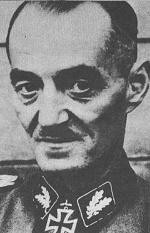
|
| SS-Oberfuehrer Dirlewanger |
Funny or not, Dirlewanger's
men conduct had been so atrocious that it could not be stomached, even by some senior members of the SS. Krueger, Police Commandant
of Cracow, had been particularly vehement, bellowing at Dirlewanger: "If this bunch of criminals has not disappeared from
this area within one week, I'll jail them personally!" Himmler's promising acolyte had merely shrugged and moved on with richer
pickings in the Soviet Union.
But now he was back with 16
officers and 865 men in Warsaw. Since at this stage of the war it was necessary to scrape barrels assiduously, Dirlewanger
managed to swell his numbers with assorted Moslems, Cossacks, Turkomens, Hungarians, Galicians, and Ukrainians whose hatred
of the Poles was notorious.
The Rape of Warsaw
The SS had mounted one "operation" in Warsaw, in spring 1942. Then
it had clear the Warsaw ghetto with grenades and flame-throwers, and succeeded in killing about 50,000 Poland Jews. Dispatches
of commanding officers, together with illustration, had been sumptuously bound and circulated privately among higher Nazi,
and that action was called as SS "battle honor'.
But in August 1944,
the SS found going very much harder. A considerable quantity of arms had been parachuted by RAF in spring 1944, including
PIAT guns, that could knock out tank at close range and useful for blowing holes in houses. The Poles insurgents itself have
a good discipline, and held their fire until the last moment. They were adept and industrious at making grenades, mines, and
detonator.
In numerical terms, the Poles and the Germans were reckoned to be
fairly even for most of the struggle. The Poles never lost their optimism, even cabling to their Government-in-exile in London at one point: "Initiative is in our hands."
It was a brave statement but ultimately futile. For in the suburbs
of Warsaw there prowled the sinister legions of the Dirlewangers and Kaminski. The Warsaw Risings most terrible day - Black
Friday - lay ahead.
It was clear, hot summer day that 5 August, not at all a time to
be thinking of death, let alone of the sort of hideous slaughter awaiting the innocents of Warsaw.
The units of Dirlewanger had begun assembling for their first major
counter-attack in the early hours of that sultry morning. The target was the Wola district of the city; Dirlewanger's 1st
Battalion took up a position south of the main street, Wolska Street. Meanwhile in Ochota - the southern area of Wola - some
300-400 Polish soldiers were to face 1,700 of Kaminski's men under the command of Major Frolov, a turncoat Russian.
The fact that the Poles
stood firm and prevented Kaminski from moving more than 300 yards was not due solely to Polish battle skill. The Kaminski
men did not want to attack until they were assured that they could loot and plunder to their heart's content. Although SS Command in Warsaw had fixed the attack deadline for 0800 hours, it proved quite
beyond Kaminski to keep it. Indeed he was not ready for another 90 minutes.
The German Supreme Command observed
such behaviour with a mixture of bewilderment and fury. There was a suitably withering entry in the War Diary: "Kaminski's
troops engaged, as planned. Two hours later than anticipated."
It was but a small delay for Warsaw. What happened once Kaminski
teamed up with the forces of Dirlewanger should perhaps surprise or shock no one. It was as if the subordinates of Himmler
had actually stayed their hand until then, waiting to unleash against their hated eastern foes a vast holocaust of terror
and cruelty, the ferocity of which had been kept in cold storage.
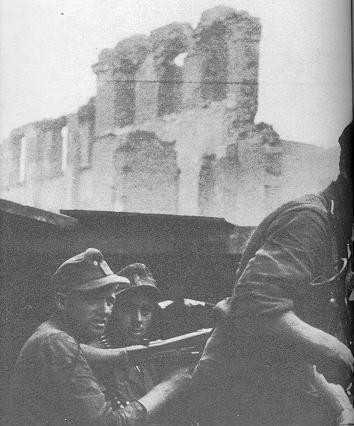
|
| Kaminski's men battling Polish partisans in Warsaw ruins. |
Himmler's two morally abysmal executioners went to work forthwith.
On 5 August, Dirlewanger's SS convicts managed to advance about 1,000 yards. Their concern was not solely getting to grips
with the Poles insurgents. Like men demented, they stormed into the houses they passed on or near the battle-line.
Inhabitants were ordered to leave. There were promises of "evacuation".
But the fate that awaited them was to be herded into cemeteries, gardens, backyards, factory forecourts and squares. Then
the murder squads set to work on men and women and children, often assembled in their nightclothes and with no time to remove
the sleep from their eyes: the prisoners were burned alive; the babies impaled on bayonets and stuck out of windows like flags;
the women were hung upside down from balconies in rows. The object, Himmler had told Goebbels, was that the sheer violence
and terror of repression would extinguish revolt "in a very few days."
The corpses were piled in large heaps, petrol was poured over them
and they were set on fire. With a strange delicacy, the killers covered over ashes and bones with the rubble of the ruined
houses. Such buildings as remained were invariably burnt down.
But this was not ending the suffering of Poles.
Dirlewanger's cohorts stormed into the hospitals in Wola and Ochota
area. The sick and wounded were shot in their beds. Sadism walked tall that day and it was turned on nuns, nurses, doctors
and voluntary helpers.
The Curie-Skiadowska Radium Institute, containing women suffering
from cancer, suffered the worst. The patients were dragged from their beds. The drunken mercenaries raped them and their nurses.
Russian and German uniforms ran amok in an orgy of murder, pillage and the 'collection' of rings and jewels, watches, and
gold. The Police units joined in the general dance of death to stiffen wavering ranks of Dirlewanger in a strange alliance
of traditional enemies united by their taste for cruelty and violence.
When it was all over, the SS reported their own losses. On the German
side, they amounted to six dead, twenty-four badly wounded, and twelve slightly wounded. When questioned on Polish losses,
the SS commander in Warsaw, SS-Gruppenführer
Reinefarth, shrugged: "Ten thousand including those shoot."
This battle also gave the Ukrainians troops ideal outlet for their
ingrained anti-Polish feelings. This caused the Poles to lump together as "Ukrainians" all the combattants from the east.
As a result if any of the latter had the misfortune to be taken prisoner by the Poles, they were all shot, either immediately
on capture or after they had a 'U' (for 'Ukrainian') painted on their naked backs and been sent to erect barricades under
fire from both sides. Thus the soldiers from the East could do no right. They were hated by one side and neither their reliability
nor their fighting ability were trusted by the other.
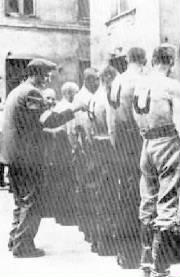
|
| Poles painted a 'U' letter on their's Eastern prisoners backs. |
Erich von dem Bach-Zelewski, who was in overall command, desperately
tried to get the advance moving again. He ordered that the mass execution of the civilian populace should cease at once, along
with the looting. The job of soldiers, after all, was to fight.
But mobs such as those of Dirlewanger and Kaminski could not by now
be stopped easily. What had they to lose? They had been told: "If you retreat or fail, you will be taken from the probationary
unit and send back to the concentration camp. If you are captured, the Poles will shoot you."
The story of the horrors perpetrated by Dirlewanger's and Kaminski's men even reached the Führer's headquarters. In his memoirs Guderian
says: "What I learnt...was so appalling that I felt myself bound to inform Hitler about it that same evening and to demand
the removal of the two brigades from the Eastern Front." Even SS-Gruppenführer Fegelein,
Himmler's chief representative at Hitler HQ, confirmed the story, saying: "It is true, mein
Führer, those men are real scoundrels."
But, as Hitler had along been privy to Himmler intention to terrorize
the Poles into submission, Guderian's "demand" must have been most unwelcome, and it is hardly surprising that "...to begin
with he was not inclined to listen." But, SS-Gruppenführer Fegelein, who enjoyed a privileged position in Hitler court because he had married Eva Braun's
sister Gretl, spoke up on Guderian behalf. Fegelein intention was primarily that of discredit Himmler, for he was one of Bormann-Kaltenbrunner
cabal, whose aim was to extend his own empires at expense of Reichsführer SS; but he could also claim a certain ancien camaraderie with
General Bor, as the two men had competed at horse trials before war. He may also, like several other senior Nazi at this time,
has begun to look over his shoulder at the possibility of arraignment for "war crimes" by victorious Allies.
At first nothing happened. Then a certain Army general named Rohr, who
was not only one of the German's most skilful tacticians, but a Prussian of the old school, a ruthless, merciless fighter
who was at same time utterly opposed to everything Himmler stood for, published an order that forwith forbade an further looting
and emphasized that all Poles prisoners should be treated as regular POWs. He
even organized several tanks to patrol the street specifically to protect the civilian population.
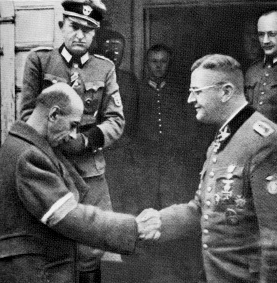
|
| General Bor (left) surrenders to SS Obergruppenführer Bach-Zelewski |
Grudgingly Hitler gave way to the Army but not before giving Bach-Zelewski
the opportunity to eliminate the freebooter Kaminski as "a possibly dangerous witness" (Guderian's words). Himmler, the last
man to stand by a friend when the going was hard, promptly dropped the former engineer. His fate was sealed. To kill him in
Warsaw, where he was surrounded constantly by an SS bodyguard, was patently impossible. So on August 19, 1944 Kaminski and
his personal staff were bundled to Lodz on some pretext and hauled before an SS military court for insubordination and theft. Two hours later the once useful Kaminski and
his staff officers were unceremoniously marched up to a wall and they were dispatched by firing-squad. To cover his fate from
his men, Kaminski death being made to look like a motoring accident.
Dirlewanger, however, was a different proposition. He still
had powerful friends in the SS. Besides, since his brigade could, if coerced, fight as a military formation, it was still
needed by von dem Bach-Zelewski. Dirlewanger himself was awarded the Knights Cross for his part in suppressing the Warsaw
Uprising.
Aftermath
The Warsaw Uprising end on 27 September 1944. During 63 days
of fighting, about 16,000 of the Polish partisan had perished or had been reported "missing, presumed dead", while 9,000 others
were taken as prisoners. But the greatest casualties of the rising were civilians: almost 200,000 perished.
The operation cost the Germans 2,000 killed and 9,000 wounded. General
Bor-Komorowski was sent to the notorious escape-proof Colditz castle and liberated at the end of the war. But his Warsaw's
foes fate were not so lucky like him.
Kaminski brigade was disbanded as a Waffen SS formation and its personnel
being sent to the Vlasov Army. Many of them were captured by Russian at the end of the war and then ended their life in gallows
or Siberian camps.
Similar fate was accompanied Dirlewanger's men. His brigade was reportedly
surrounded by the Soviets and massacred during the final battles in Berlin during late April 1945. Dirlewanger himself was
beaten to death in American captivity by his Polish guards in June 1945, as a revenge for what he had done in Warsaw.*
The only one of the butchers from the Warsaw who could escape from the
gallows or Russian gulag was SS-Obergruppenführer
Erich von dem Bach-Zelewski. Being a prosecutor witness against his Nazi bosses in Nuremberg, he only served a few years prison
and died on his estate bed in 1971. The exploit confirmed Hitler opinion that "this Bach-Zelewski is one of the cleverest
of men."
Notes
* There is other story about Dirlewanger fate after
the war. In his book, Barbarossa: The Russian-German Conflict, 1941-45,
Alan Clark said that Dirlewanger was surrounded with the remains of his brigade
in Halbe in April 1945. In one of the most gruesome massacres of Eastern Campaign, the Red Army massacred the entire unit
and many German civilians. Dirlewanger is rumored to have escape by hiding under a pile bodies. Later, when the West Allies
captured him, Dirlewanger bribed his way out. He surfaced in Egypt in 1955 and became one of ex-Nazis that Nasser used to
help his secret services war against Israel.
|



